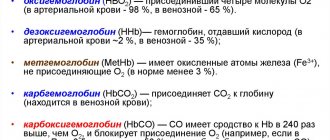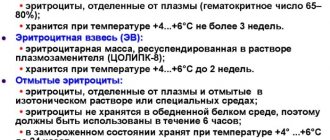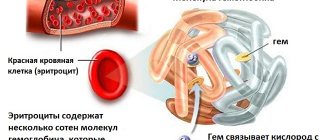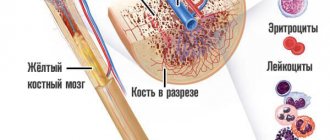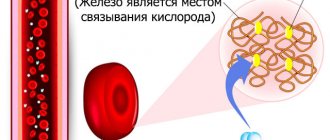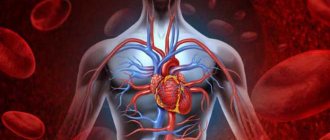Hemoglobin and its analysis is an extremely important protein in our body. As an integral part of red blood cells (erythrocytes), it delivers oxygen to all parts of the body. This article will show the health benefits and harms of elevated hemoglobin levels. In addition, we will discuss hemoglobin laboratory tests, normal values, and reference ranges.
This is the third article in a series of articles on hemoglobin
- Hemoglobin: ways to increase or decrease
- Hemoglobin: reasons for low or high levels
This article is based on the findings of 28 scientific studies.
The article quotes the following research authors:
- Department of Biological Sciences, Carnegie Mellon University Pittsburgh
- Department of Molecular Physiology and Biophysics, University of Virginia
- Department of Neurobiology, Harvard Medical School
- Department of Laboratory Medicine and Pathology, University of Alberta
- Center for Evolutionary Medicine, University of Zurich
- Karolinska Institutet and Stockholm Gerontology Research Center
- and others.
Please note that the numbers in parentheses (1, 2, 3, etc.) are clickable links to peer-reviewed scientific studies. You can follow these links and read the original source of information for the article.
Hemoglobin structure
hemoglobin (Hb) consists of four proteins (subunits). These proteins are called chains. Most normal hemoglobin consists of two alpha and two beta chains. [].
Each of the four chains contains a heme part. “Chem” is the chemical structure where iron is found. It binds oxygen, carbon monoxide, or other small molecules such as nitric oxide. [,]
Iron, found in hemoglobin, is responsible for the red color of our blood.
Hemoglobin structure
Harmful “abilities” of Hb
In addition to bonding with oxygen, heme protein also interacts with carbon monoxide (CO). As a result of this reaction, it is transformed into a strong compound - carboxyhemoglobin, which negatively affects the physiological properties of red blood cells. First of all, an excess of carboxyhemoglobin threatens the development of the following consequences:
- hypoxia;
- vomiting, nausea;
- dizziness;
- migraine;
- acute renal failure;
- hemorrhagic shock.
Attention! In more severe cases, death is possible.
Any disturbances in the structural structure of hemoglobin are called hemoglobinopathies in medicine. This condition is often accompanied by hereditary blood pathologies, for example, thalassemia, sickle cell anemia. If the protein reacts with glucose, glycated Hb is formed. This type of hemoglobin does not provide any benefit to the body. Often indicates the development of diabetes mellitus or a high risk of developing this disease.
A normal hemoglobin level in the blood is the key to the health of the body, because even minor deviations from the norm can affect the quality of life. When protein levels change, it is necessary to adjust your diet and daily routine, and give up bad habits. Drug therapy should only be administered by the attending physician.
Hemoglobin function
The main function of hemoglobin is to transport oxygen from the lungs to the tissues of the body, and carbon dioxide (CO2) from the tissues to the lungs. [, ]
However, it also reacts with two other gases—carbon monoxide (CO) and nitric oxide (NO). []
The human body contains about 750 grams of hemoglobin, mainly found in red blood cells (erythrocytes). []
A mature red blood cell contains approximately 270 million hemoglobin molecules. []
Finally, each hemoglobin molecule is capable of binding four oxygen molecules, which allows each red blood cell to carry more than one billion oxygen molecules. []
Note that inside the body, pH (acid-base balance) and temperature tend to be in a very narrow range - 7.35-7.45 and 36.11-37.67 degrees, respectively [].
Besides blood, hemoglobin appears to play some unexpected roles in other tissues.
Hemoglobin chains are also present in white blood cells (macrophages), blood vessel walls (endothelial cells), lungs (alveolar cells), lens of the eye, kidneys (mesangial cells), and dopamine-releasing neurons. [,]
In the wall of a blood vessel, hemoglobin chains help control the level of nitric oxide, and thus participate in the contraction or dilation of blood vessels. This means that hemoglobin affects blood pressure , blood flow, and oxygen delivery to tissues.
On the other hand, hemoglobin in dopamine-releasing neurons appears to be involved in mitochondrial function and may play a role in normal brain physiology. []
Blood composition structure
Functions
The functions of hemoglobin are to ensure the respiratory process in the body, which is carried out in three stages:
- cellular respiration - cells are saturated with oxygen;
- external respiration - oxygen enters the lungs, and carbon dioxide is released by the body;
- internal respiration - in the lungs, oxygen captures hemoglobin, they are transformed into oxyhemoglobin and distributed to all cells.
That is why an imbalance of this protein can lead to extremely negative consequences, and in some cases even death.
Types of hemoglobin
In the blood cells of healthy adults []:
- 97% of total hemoglobin is of the HbA type (two alpha and two beta chains)
- 2.5% – HbA2 type (with two alpha and two delta chains)
- 0.5% - type HbF or fetal hemoglobin (with two alpha chains and two gamma chains).
As the name suggests, fetal hemoglobin makes up 80% of the hemoglobin in newborn babies. [] Fetal hemoglobin has a slightly higher ability to capture oxygen than does adult hemoglobin. []
After birth, the child's body gradually switches to the adult type of hemoglobin over several months. [] As a rule, by the end of the first year of life, “adult” hemoglobin (type A and A2) already predominates in children. []
In some cases, fetal hemoglobin is retained in adult red blood cells. This condition is mostly asymptomatic and is known as hereditary persistence of fetal hemoglobin. []
Deviations from the norm
A decrease in hemoglobin in the blood is diagnosed several times more often than an increase in this component. Any deviation from the norm requires the appointment of additional studies.
Elevated Hb
An increase in hemoglobin concentration is a rare condition, which is often a consequence of the physiological characteristics of the body and some unfavorable external factors. High values are sometimes associated with smoking and living in megacities where the air is heavily polluted.
A change in the indicator towards growth may indicate the development of pathological conditions:
- cardiovascular diseases;
- respiratory failure;
- disruption of the gastrointestinal tract;
- tumor process;
- polycystic kidney disease;
- dehydration;
- erythremia.
There are no specific signs of high levels of this blood component. Usually a person complains of symptoms characteristic of a particular disease.
Reduced Hb
A decrease in hemoglobin concentration indicates the development of anemia. First of all, the signs of anemia are associated with oxygen starvation that the body experiences. These include:
- increased weakness;
- rapid fatigue;
- drowsiness;
- dizziness;
- headache;
- dyspnea;
- pale skin.
Experts identify several main reasons for the development of this pathological condition:
- diet;
- unbalanced diet;
- hidden and open bleeding;
- hemolytic anemia;
- chronic pathologies of the gastrointestinal tract;
- autoimmune diseases;
- tumors;
- skin burn;
- bronchial asthma;
- inflammatory processes in the body.
The listed conditions provoke iron deficiency in the blood, which is expressed in a decrease in hemoglobin. But a decrease in protein does not always indicate a serious illness. Sometimes a change in the blood can be caused by a condition after surgery, injury, or stress. In women, a short-term decrease is observed during menstruation.
Hemoglobin metabolism
When blood cells age and/or become damaged, hemoglobin passes into the blood. There are several molecules in our blood that recognize and bind free hemoglobin, including haptoglobin and hemopexin. [].
Haptoglobin is the primary scavenger in the blood to seek out and collect free hemoglobin. []
It irreversibly binds to hemoglobin, which circulates freely in the blood and transports it to special white blood cells called monocytes or macrophages. []
These cells convert heme groups into biliverdin (a bile pigment) as well as carbon and iron oxides. []. Iron is commonly used in new red blood cells. []
Free hem has potentially toxic properties due to the catalytically active iron atom it coordinates. (https://www.frontiersin.org/articles/10.3389/fphar.2014.00061/full)
In case of massive destruction of red blood cells, which occurs in some diseases, free hemoglobin is also cleared by the kidneys. However, kidney excretion is accompanied by the release of free iron, which causes organ damage from oxidative stress. []
What is the danger of high hemoglobin?
Thick blood increases the risk of serious health problems:
- Thrombophlebitis, which can develop into thromboembolism;
- Heart attack and stroke;
- Sickle anemia, when blood cells change their shape and cease to perform their functions normally;
- During pregnancy, fetal development slows down, confusion and cognitive impairment occur.
In general, this leads to a deterioration in overall health, constant malaise and a decrease in quality of life.
Diagnostic methods
The above symptoms can occur in various diseases, and in order to determine your hemoglobin level, you need to undergo an examination. This is done using a general blood test.
If the diagnosis is confirmed, the doctor will review your medical history in detail, prescribe additional tests, ask clarifying questions about your well-being, assess the condition of your skin, hair, nails and mucous membranes, measure your blood pressure, and may also give a referral to specialists. This will help determine the cause of low hemoglobin and solve the problem faster.
Means for increasing hemoglobin
If your hemoglobin level is low, you need to take iron supplements. Moreover, this must be done for at least 3-4 months in a row. But as I wrote above, this is problematic for many, since most drugs often cause side effects: vomiting, nausea, heartburn, belching, abdominal pain, poor appetite and diarrhea. It is especially difficult for children and pregnant women.
Several years ago, a form of carbonyl iron was developed that is completely non-toxic and contains no metal salts. It is better absorbed, so the daily dosage is lower than most analogues.
Today there is only one product with carbonyl iron, it is called BoostIron . Its additional ingredients:
- Vitamin C
- Vitamin B12
- Folic acid
They help the iron to be better absorbed and bring additional benefits to the body.
More information about BoostIron can be found HERE.
Attention! In order not to run into a fake, I advise you to order carbonyl iron on the official website of Santegra Shop .
Using coupon number 2888 you will receive a 5% discount and save on shipping.
What foods quickly increase hemoglobin?
There are certain foods that have a good effect on the process of hematopoiesis and hemoglobin levels, these include:
- Liver (any will do)
- Meat (especially rabbit, pork and beef)
- Buckwheat
- Beet
- Carrot
- Nuts
- Honey
- Egg yolk
- Chocolate
- Currant
- Turmeric
- Halva
- Pomegranate
- Dried fruits
- Caviar
- Dried nettle (as a spice)
- Rose hip decoction
- Strawberry
- Parsley
Normal hemoglobin level
Normal hemoglobin test values may vary depending on age and gender. They may also vary slightly between laboratories.
- Newborns: 14 to 24 g/dL
- Children: 9.5 to 13 g/dL
- Men: 13.5 to 17.5 g/dL
- Women: 12 to 15.5 g/dL
- Older men: 12.4 to 14.9 g/dL
- Older women: 11.7 to 13.8 g/dL
Normal hemoglobin levels decrease during pregnancy[,].
Iron-containing foods for anemia
Weakness, drowsiness, constant fatigue, pale skin and dull hair. I’m tired, you tell yourself. And you take a vacation or try to improve your appearance with the help of a cosmetologist, instead of urgently going to the doctor and doing a general blood test. The listed symptoms simply “scream” that the body does not have enough iron. The condition is called iron deficiency anemia - the most common type of anemia.
Why is iron deficiency anemia dangerous?
To explain it quite simply, a lack of iron deprives the blood of the ability to fully nourish all the cells of the body with oxygen. Including the brain and heart. Today everyone already knows that low hemoglobin in a general blood test means anemia. After all, it is precisely this iron-containing protein that carries oxygen to all corners of our body.
A decrease in iron content can occur for various reasons - large blood loss, diseases of the digestive tract, helminthic infestation, cancer, pregnancy. But the most basic and common cause is a lack of iron-containing foods in the diet. Sometimes it is enough to adjust your diet so that hemoglobin is restored to the required levels.
What do you need to know when creating a menu?
Simply eating iron-containing foods for anemia is not enough. You need to know what you can combine them with and what you can’t. There are antagonist minerals, there are substances that reduce the absorption of iron, there are vitamins and microelements that improve its absorption. Armed with this knowledge, you can defeat iron deficiency anemia without the use of synthetic drugs.
Iron is different from iron
There are two types of iron-containing foods - animal and plant. Both are the basis of our nutrition. Animal foods - red meat, fish, seafood, liver and other organ meats - contain heme iron. Plants are a source of non-heme. How is it different? In meat it is found in the form of hemoglobin, from which iron is absorbed much better. In plants it is present in a different form. Our body absorbs it in much smaller quantities. Vegetarians have the worst situation in this situation. They need to eat almost 2 times more food than “meat eaters” in order to maintain normal hemoglobin levels.
Hemoglobin: the benefits of increased values
Hemoglobin supplies oxygen
We cannot live without hemoglobin. It supplies oxygen to the body tissues and maintains all body functions.
However, hemoglobin also has some other, lesser-known beneficial functions, listed below.
Hemoglobin dilates blood vessels
Hemoglobin is capable of producing and releasing nitric oxide (NO) molecules. []
It seems that hemoglobin is increasingly unable to take up and carry oxygen when the body enters an environment with low oxygen levels (hypoxia). But as it turns out, hemoglobin can increase the flow of blood and oxygen to the body's organs by dilating blood vessels and thereby increasing blood flow. [].
Blood consists of a liquid part - plasma and a solid part (elements), which includes red blood cells, white blood cells and platelets.
Hemoglobin is important for brain function
Several large studies have shown that anemia or low hemoglobin can predict the development of dementia or brain problems. [].
Anemia increases the risk of developing dementia due to chronically reduced oxygen delivery to the brain [].
A study of 322 patients found that children with anemia performed worse on two mental task tests . []
Older people with low hemoglobin levels (below 13 g/dL in men and 12 g/dL in women) had a higher risk of developing dementia 3 years after hemoglobin reduction (study of 1,435 older people). []
Likewise, people with anemia showed a 60% increased risk of developing Alzheimer's disease (study of 881 older adults). []
Hemoglobin protects against lung infections
Low hemoglobin levels are a risk factor for acute lower respiratory tract infections in children (study of 110 children with low hemoglobin and 110 control children). Anemic patients are 4.6 times more susceptible to lower respiratory tract infections. []
Normal hemoglobin levels prevent postpartum depression
Women suffering from early postpartum anemia have an increased risk of developing postpartum depression (study of 37 women). []
Hemoglobin promotes faster recovery
Adequate hemoglobin levels are important for our body to function properly. This is especially true for people with various disorders and diseases.
Anemia is associated with worse clinical outcomes, including increased length of hospital stay, decreased quality of life, and increased risk of morbidity and mortality. []
Hemoglobin may help reduce pain
Some hemoglobin-derived peptides have opiate activity. [] This means that they can potentially relieve (reduce) pain.
Why does hemoglobin decrease?
This problem is widespread throughout the world and affects almost a third of the world's population. Most often, hemoglobin levels decrease due to an unbalanced diet, as well as as a result of certain diseases.
In women, low hemoglobin is observed much more often than in men. This is due to monthly blood loss during menstruation and pregnancy. Also, there are a number of reasons that can affect any of us, regardless of gender and age.
- Problems with the gastrointestinal tract. For example, gastritis, stomach ulcer, duodenal ulcer, etc.
- Infectious and autoimmune diseases
- Long-term protein-free diets and vegetarianism
- Blood loss caused by trauma, surgery and occult bleeding
- Disturbance in the functioning of the thyroid gland when hormonal imbalance occurs
- Long-term stress
- Unbalanced diet
- Lack of vitamins C and B12
- Constant and too intense physical activity associated with sports and professional activities
- Parasite infestation
- Oncology
- Liver diseases
Low hemoglobin in children
Babies born one to two months premature often lack iron-containing protein. This happens due to the rapid breakdown of red blood cells and the slow renewal of protein by the bone marrow.
Also, a lack of hemoglobin in newborns may be associated with infectious diseases of the mother and hereditary characteristics of the body.
Why is low hemoglobin dangerous?
- The immune system works worse. Colds, which are much more difficult to tolerate, are becoming more common.
- There is a malfunction in the functioning of all systems and organs of the body.
- Heart failure develops.
- The risk of vascular atherosclerosis increases.
- The liver increases in size.
- The emotional state worsens.
- Mental activity decreases.
- At the most advanced stage, death can occur.
Signs of low hemoglobin
The danger is that at first, the symptoms of a lack of iron-containing protein can be easily confused with a general malaise caused by fatigue. But over time they become more pronounced and begin to cause serious discomfort.
- Skin becomes pale and dehydrated
- Frequently feel dizzy and have headaches
- Appetite is impaired or completely lost
- The tongue takes on a bright red tint, and non-healing wounds appear in the corners of the mouth.
- Troubled by numbness or cramps in the legs
- Hair loses shine, breaks and falls out
- The nail plate becomes brittle and lumpy
- Heart rate increases
- Shortness of breath appears at the slightest physical exertion
- There is stool disorder (diarrhea)
- Blood pressure rises
- Lips are peeling
- Potency decreases in men
- Taste sensations change
- Performance deteriorates
- Loss of energy and absent-mindedness appears
- Nausea and vomiting occurs
Excess hemoglobin
This also happens and the reasons may be as follows:
- Intestinal obstruction
- Cardiovascular failure
- Congenital heart defect
- Hormonal disorders that cause the production of red blood cells to cease
- Blood transfusion
- Impaired respiratory function, for example due to pulmonary fibrosis
Also, elevated hemoglobin levels can be observed in smokers and people living high in the mountains. In both cases, the body requires more oxygen, so the volume of iron-containing protein increases.
Symptoms
An excess of hemoglobin is manifested by the following symptoms:
- The skin, tongue, palate and sclera of the eyes acquire a yellowish tint;
- Skin itching appears;
- Weight loss occurs;
- The palms, armpits and old scars become covered with pigment spots;
- The liver enlarges;
- Heart rhythm is disturbed;
- Weight loss
- Vision deteriorates
Hemoglobin: harm from elevated values
Hemoglobin has a number of side effects. This occurs either when levels are high or when large amounts of free hemoglobin are released into the bloodstream due to increased destruction of red blood cells.
Hemoglobin increases oxidative stress
Hemoglobin releases significant amounts of reactive oxygen species (ROS) [].
To combat this problem, red blood cells are equipped with highly effective antioxidant defenses. They contain enzymes such as Cu/Zn superoxide dismutase (SOD1), catalase, glutathione peroxidase (GPX-1), and peroxiredoxins (Prdx1 and Prdx2). Glutathione (GSH) also contributes to this protection [].
Mechanisms of protection against free heme formed during the oxidation of hemoglobin.
As long as hemoglobin is contained in red blood cells, these reactive oxygen species are contained. However, when red blood cells burst and allow hemoglobin to enter the bloodstream freely without these antioxidants, that hemoglobin begins to cause oxidative damage to the body's blood vessels and tissues. []
This occurs when scavengers (such as haptoglobin) cannot effectively remove all free hemoglobin from the blood. []
Tests to determine the amount of hemoglobin in the blood
Total hemoglobin is determined using a clinical blood test. This laboratory test is basic; it is carried out in the diagnosis of almost all pathologies; therefore, changes in Hb levels are often determined by chance during diagnostic or preventive measures.
The day before donating blood, the patient needs to give up physical activity, smoking and taking medications (with the doctor’s permission). Biological fluid is collected in the morning on an empty stomach. The examination result will be ready the next day. Some laboratories conduct rapid research in a few hours. When the test shows abnormalities, repeat blood sampling will be required. To determine hemoglobin in the blood outside the laboratory, a special portable device is used - a hemoglobinometer. The device allows you to automatically assess your Hb level.
Buffer function
The human body is designed in such a way that the pH of the blood should be constant and equal to approximately 7.4. Buffer systems help maintain blood pH.
The hemoglobin buffer system makes up 75% of the total buffer capacity of the blood. Hemoglobin performs its buffering function due to the timely removal of carbon dioxide from the bloodstream, which in large quantities reduces the pH of the blood (acidifies).
Blood buffer capacity
The total buffer capacity of the blood is 25.3 mmol/L for arterial blood and 24.3 mmol/L for venous blood.
The buffer capacity of hemoglobin is 75% of the buffer capacity of blood, i.e. 18.2-19.0 mmol/l. The share of hemoglobin in the buffer capacity of the whole organism (blood and intercellular substance) is much less.
Role in the human body
Lack of Hb, even if it is moderate, can lead to insufficient oxygen supply to the cells of the whole body and, as a result, all organs will suffer from hypoxia, which will certainly affect health and general well-being. A decrease in hemoglobin levels below normal is called anemia and has varying degrees of severity. With anemia, a person may complain of fatigue, weakness, loss of strength, decreased appetite, pale skin, brittle nails and hair, weight loss, sleep disturbance, palpitations, tachycardia, hypotension, shortness of breath, irritability, emotional instability, decreased immunity. If you have any of the above complaints for no apparent reason, then you should take a general blood test. There is also the opposite condition - hyperhemoglobinemia, which is much less common, but the causes and consequences of its occurrence are no less dangerous.
Increased hemoglobin level
An increase in hemoglobin concentration is less common than a decrease, but also poses a danger to the patient’s health, as this means an increase in blood viscosity. For humans, this pathological condition is fraught with an increase in the number of red blood cells, which contributes to the formation of blood clots.
Increased hemoglobin may be a consequence of:
- Erythrocytosis is a disease characterized by a pathological increase in the number of red blood cells.
- Dehydration, which occurs due to extensive burns or prolonged diarrhea and vomiting.
- High hemoglobin can be detected in the initial stages of the development of heart and pulmonary failure.
- A factor in the occurrence of pathology is intestinal obstruction.
For some people, an increase in hemoglobin concentration that is noticeably higher than the average is normal for obvious reasons. A similar picture is typical for people living in high mountains, climbers after climbing, and pilots.
Do not self-medicate. Your doctor will help you return your readings to normal. For an integrated approach, adjust the menu by excluding foods high in iron.
Pathological types of hemoglobin
In some cases, under the influence of genetic defects, abnormal synthesis of hemoglobin cells occurs. Pathological types of hemoglobin differ from physiological ones in the composition of polypeptide bonds, or more precisely, in their mutation.
As a result of DNA mutation, the synthesis of erythrocyte components is carried out not with glutamine, but with valine amino acid. This “frame” replacement leads to the formation of a type 2 protein structure with a “sticky” region on the surface that is capable of assigning structures to its own kind. Thus, polymerization of HbS molecules occurs and, as a result, sedimentation of heavy and poorly transported red blood cells in the blood vessels. This deviation is called “sickle-shaped anemia”.
Diagnosis of hemoglobin
To determine the concentration of globin respiratory structures in human blood, qualitative and quantitative types of analyzes are carried out. Hemoglobin is also examined for the amount of iron ions it contains.
The main quantitative method for determining hemoglobin concentration today is colorimetric analysis. It is a study of the color saturation of a biological material when a special reagent is added to it.
Qualitative methods include blood testing to determine the ratio of HbA and HbF types. Qualitative analysis also includes determining the amount of glycated hemoglobin molecules (compounds with carbons) in the blood - the method is used to diagnose diabetes mellitus.

